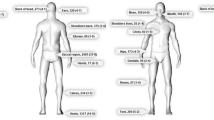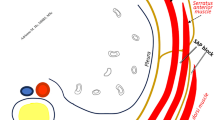Abstract
Background
Inadequately treated pain is associated with significant morbidity in older adults. We aimed to describe current pain management practices for patients with fragility pelvic fractures, a common emergency department (ED) presentation in older adults.
Methods
We performed a health records’ review of adults ≥ 65 years old who presented to two academic EDs with nonoperative fragility pelvic fractures between 01/2014 and 09/2018. The primary outcome measures were type and timing of analgesic medications. Secondary outcome measures included ancillary service consultation, ED length of stay, admission rate and rate of return to ED at 30 days. Data were reported using descriptive statistics.
Results
We included 411 patients. The majority were female (339, 82.5%) with mean age 83.9 (SD 8.1) years. Nearly, one-third (130, 31.6%) did not receive any analgesia for their fracture. Analgesia was initiated in 123 (29.9%) patients through paramedic and nursing medical directives; 244 (59.4%) patients received physician-initiated opioids (hydromorphone 228 (55.5%); morphine 28 (6.8%)). Only 23.1% of patients received one or more ancillary services: physiotherapy (10.5%), social work (7.3%), geriatric nurse assessment (14.1%), and homecare (3.9%). Mean ED length of stay was 11.6 (SD 7.1) h; 210 (51.1%) patients were admitted; of those discharged, 45 (22.4%) returned to the ED within 30 days.
Conclusion
One in three older adults presenting to the ED with nonoperative fragility pelvic fractures receive no analgesia during the course of their prehospital and ED care. Barriers to quality care must be identified and processes implemented to ensure adequate pain management for this population.
Résumé
Contexte
La douleur insuffisamment traitée est associée à une morbidité importante chez les personnes âgées. Nous voulions décrire les pratiques actuelles de gestion de la douleur chez les patients souffrant de fractures pelviennes de fragilité, une présentation courante des services d’urgence (SU) chez les personnes âgées.
Méthodes
Nous avons effectué une revue des dossiers médicaux des adultes ≥ 65 ans qui se sont présentés à deux urgences universitaires avec des fractures pelviennes de fragilité non opérées entre 01/2014 et 09/2018. Les principaux critères d'évaluation étaient le type et le moment de la prise de médicaments analgésiques. Les critères d'évaluation secondaires comprennent la consultation des services auxiliaires, la durée moyenne de séjour aux urgences, le taux d'admission et le taux de retour aux urgences à 30 jours. Les données ont été rapportées en utilisant des statistiques descriptives.
Résultats
Nous avons inclus 411 patients. La majorité était des femmes (339, 82,5%) avec un âge moyen de 83,9 (écart-type 8,1) ans. Près d'un tiers (130, 31,6 %) n'ont reçu aucune analgésie pour leur fracture. L'analgésie a été initiée chez 123 (29,9%) patients par des directives médicales paramédicales et infirmières ; 244 (59,4%) patients ont reçu des opioïdes à l'initiative du médecin (hydromorphone 228 (55,5%) ; morphine 28 (6,8%)). Seuls 23,1% des patients ont bénéficié d'un ou plusieurs services auxiliaires : physiothérapie (10,5%), travail social (7,3%), évaluation infirmière gériatrique (14,1%) et soins à domicile (3,9%). La durée moyenne de séjour aux urgences était de 11,6 heures (écart-type : 7,1); 210 (51,1 %) patients ont été admis ; parmi ceux qui sont sortis, 45 (22,4 %) sont retournés aux urgences dans les 30 jours.
Conclusion
Une personne âgée sur trois se présentant aux urgences avec des fractures du bassin non opératoires ne reçoit aucune analgésie au cours de ses soins préhospitaliers et aux urgences. Les obstacles à la qualité des soins doivent être identifiés et des processus doivent être mis en œuvre pour assurer une gestion adéquate de la douleur pour cette population.
Similar content being viewed by others
References
Daoust R, Paquet J, Lavigne G, Sanogo K, Chauny JM. Senior patients with moderate to severe pain wait longer for analgesic medication in EDs. Am J Emerg Med. 2014;32(4):315–9.
Hwang U, Platts-Mills TF. Acute pain management in older adults in the emergency department. Clin Geriatr Med. 2013;29(1):151–64.
Kannus P, Palvanen M, Niemi S, Parkkari J, Jarvinen M. Epidemiology of osteoporotic pelvic fractures in elderly people in Finland: sharp increase in 1970–1997 and alarming projections for the new millennium. Osteoporos Int. 2000;11(5):443–8.
Mears SC, Berry DJ. Outcomes of displaced and nondisplaced pelvic and sacral fractures in elderly adults. J Am Geriatr Soc. 2011;59(7):1309–12.
Rommens PM, Arand C, Hofmann A, Wagner D. When and how to operate fragility fractures of the pelvis? Indian J Orthop. 2019;53(1):128–37.
Brown JC, Klein EJ, Lewis CW, Johnston BD, Cummings P. Emergency department analgesia for fracture pain. Ann Emerg Med. 2003;42(2):197–205.
Daoust R, Paquet J, Piette E, Sanogo K, Bailey B, Chauny JM. Impact of age on pain perception for typical painful diagnoses in the emergency department. J Emerg Med. 2016;50(1):14–20.
Hsu JR, Mir H, Wally MK, Seymour RB, Orthopaedic Trauma Association Musculoskeletal Pain Task F. Clinical practice guidelines for pain management in acute musculoskeletal injury. J Orthop Trauma. 2019;33(5):158–82.
Dunham M, Schofield P, Knaggs R. Evidence-based clinical practice guidelines on the management of pain in older people – a summary report. Br J Pain. 2013;7(3):152–4.
Terrell KM, Hustey FM, Hwang U, Gerson LW, Wenger NS, Miller DK. Quality indicators for geriatric emergency care. Acad Emerg Med. 2009;16(5):441–9.
Acknowledgements
We thank Ms. Angela Marcantonio for her assistance with this project.
Funding
There are no funding sources.
Author information
Authors and Affiliations
Contributions
ET was responsible for study development, data collection, monitoring of data abstraction, and writing of the manuscript. MMA assisted with data abstraction and contributed to the methods section of the manuscript. MJN provided valuable input on data analysis and contributed to the analysis section of the manuscript. DE, MA and KY were involved with study design and development. All the authors provided substantive feedback on the manuscript.
Corresponding author
Ethics declarations
Conflict of interest
The authors have no conflicts of interest to declare.
Supplementary Information
Below is the link to the electronic supplementary material.
Rights and permissions
About this article
Cite this article
Tran, U.E., Yadav, K., Ali, M.M. et al. An evaluation of emergency pain management practices in fragility fractures of the pelvis. Can J Emerg Med 24, 273–277 (2022). https://doi.org/10.1007/s43678-022-00265-5
Received:
Accepted:
Published:
Issue Date:
DOI: https://doi.org/10.1007/s43678-022-00265-5




